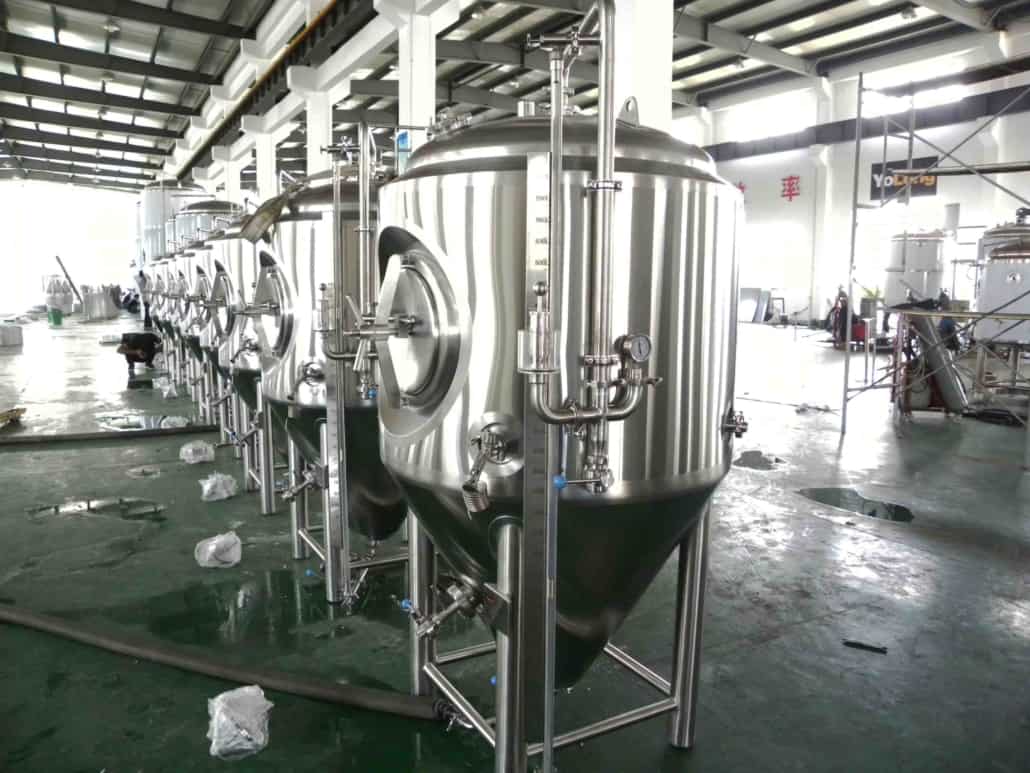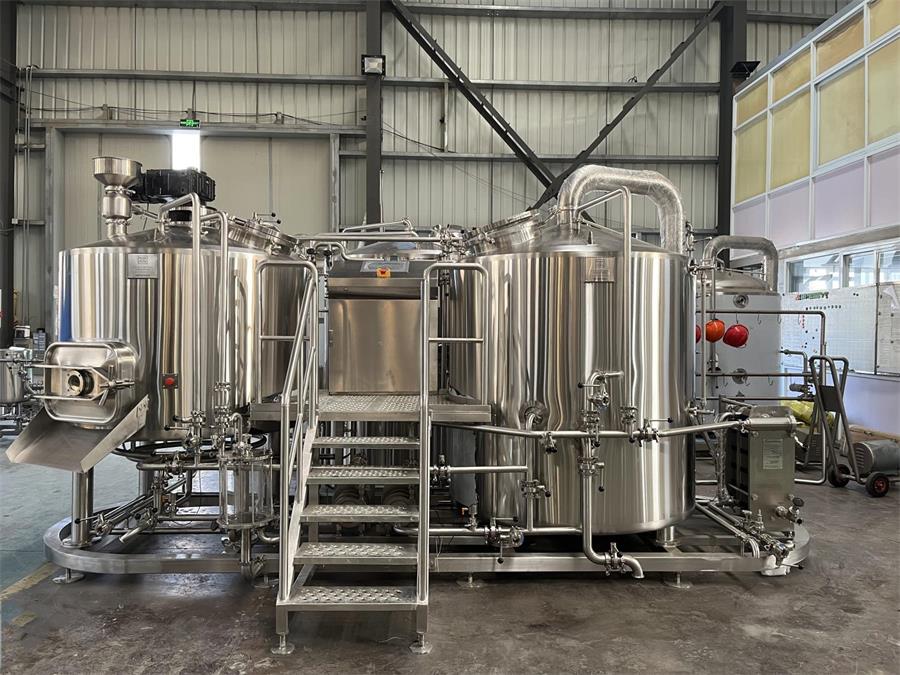beer making machine
beer making machine is a popular hobby that allows you to create customized brews. Having the right equipment makes the process much easier. This guide provides an overview of the key equipment needed at different stages of the beer production process.
Types of Beer Making Equipment
The main types of equipment for making beer at home include:
| Equipment | Description |
|---|---|
| Brew kettle | Heats water and grain mixture to extract sugars and flavors. Stainless steel kettles with temperature controls work best. |
| Fermenter | Food-grade plastic or stainless steel bucket where fermentation occurs. Must have tight seal. |
| Airlock | Allows CO2 to escape without letting air in during fermentation. Attaches to drilled hole in fermenter lid. |
There are also many accessories like thermometers, tubing, sanitizers, bottles, and more used in the beer making process.

Overview of the Beer Brewing Process
The main stages of beer production include:
- Mashing – The grains are steeped in hot water to convert starch into fermentable sugar. This takes 1-2 hours.
- Boiling – The mash is filtered and boiled with hops for 60-90 minutes. This adds flavors and bitterness.
- Fermenting – Yeast is added to start fermentation, converting sugars into alcohol. This takes 1-4 weeks.
- Bottling – The final beer is packed into bottles or kegs along with some sugar and yeast. It carbonates and conditions for 2-4 weeks.
The proper equipment is needed at each stage to hold ingredients, control temperature, ferment cleanly, and bottle securely.
Beer Making System Capacity, Design and Customization
Home brewing systems are available in different batch sizes and configurations:
| Size | Batch Volume | Description |
|---|---|---|
| Small | 5-10 liters | Countertop systems for new brewers. Limited customization. |
| Medium | 20-100 liters | Freestanding systems on wheels provide flexibility. Modular options allow some customization of vessels, valves, etc. |
| Large | 200+ liters | Commercial-grade, made-to-order brewhouses. Fully customized to match brewery operations and space. |
Larger systems allow brewing higher volumes per batch. They can also accommodate more customization of tank numbers, shapes, valves, welds, automation, etc. But they require more space and have higher equipment cost.
Beer Brewing Equipment Suppliers and Pricing
There are many equipment manufacturers catering to commercial and home brewers:
| Supplier | Products | Price Range |
|---|---|---|
| Blichmann Engineering | Kettles, burners, conical fermenters | 500 |
| Spike Brewing | Kettles, conicals, eBIAB systems | 80 |
| Northern Brewer | Full brewery kits for beginners |
Prices range from under $100 for basic homebrew kits to over $10,000 for commercial-scale stainless steel brewhouses. Choosing reputable manufacturers ensures durable, food-safe equipment.
Installing and Operating Beer Making Machinery
Proper installation and operation ensures efficiency, safety and beer quality:
| Activity | Guidelines |
|---|---|
| Installation |
|
| Operation |
|
| Maintenance |
|
Partnering with an experienced brewery engineering firm is advised for larger professional installations. They can ensure optimized layout and safety.
How to Select the Right Beer Brewing Supplier
Choosing an equipment vendor involves evaluating several factors:
| Factor | Considerations |
|---|---|
| Reputation |
|
| Offerings |
|
| Services |
|
Getting quotes from multiple vendors allows detailed comparison on pricing, quality and service terms. Site visits to view product samples and manufacturing also help inform supplier selection.
Pros and Cons of Commercial Beer Brewing Systems
Commercial-scale equipment has some clear advantages but higher costs as well:
| Pros | Cons | |
|---|---|---|
| Production Volume | Large batch sizes for wider distribution and sales | Higher equipment investment and operating expenses |
| Automation | Improves consistency and labor efficiency | Requires technical skill to program and maintain |
| Quality | Commercial-grade parts improve durability | Harder for new brewers to achieve flavor complexity |
Choosing Between New or Used Brewing Systems
Setting up a commercial brewery involves deciding between purchasing new or previously-owned equipment. There are tradeoffs to consider:
| New Systems | Used Systems | |
|---|---|---|
| Cost | Higher initial price | Discounted from depreciation |
| Condition | Latest technology | May have wear/tear |
| Lead Time | 3-6 months for custom fabrication | Ready for quick delivery |
| Warranties | Full manufacturer coverage | None or limited |
Inspecting equipment and getting experienced consultation is vital before purchasing used systems. New custom systems take longer but carry less risk.
Key Considerations for Planning a Brewery Layout
The physical brewery layout impacts efficiency. Below are important considerations:
- Optimize process flow from raw materials to finished goods loading bays.
- Position heavy equipment like mills, kettles and fermenters near structural building supports.
- Ensure adequate spacing for material movement, cleaning and maintenance access.
- Locate noisiest, hottest equipment away from offices/taprooms.
- Design flexibly to accommodate future expansion or process changes.
- Comply with safety, building, and environmental codes for commercial food/beverage facilities.
While equipment determines fundamental layout, customizing the structure and floorplan allows optimizing for budgets and site constraints.

Calculating Costs of Equipping a Brewery
Major costs when equipping a brewery include:
- Fixed asset investments – Brewhouse vessels, plumbing, automation, cooling systems. Typically 50-70% of start-up costs.
- Utilities – Electric/gas/water connections, wiring, wastewater lines. Varies based on site.
- Facilities – Building shell, flooring, lighting, construction fees. Often 20-30% of capital.
- Auxiliary purchases – Ingredient handling, cleaning, lab equipment. 5-10% range.
- Other – Design/engineering, permitting, contingency funds.
Total equipment capital expenditure averages $200-$500 per annual barrel brewing capacity for typical craft breweries. Developing detailed lists then obtaining vendor quotes is key for accurate budgeting.
Options for Financing and Managing Costs
Acquiring financing helps new brewers afford major equipment purchases:
- Small business administration loans provide accessible financing for US-based brewers.
- Crowdfunding generates capital from a community investor base.
- Grants are offered in some regions to encourage brewery startups.
- Partner investors add expertise while sharing risk and startup costs.
Phasing growth also helps manage costs through incremental capacity expansion after establishing reputation and distribution.
Leasing equipment or buying second-hand can reduce initial outlay. Lower risk designs focusing on core vessels first also provide cost control opportunities.
Frequently Asked Questions (FAQ)
1) What size beer making machine should a beginner buy?
- Start with a small 5–10 L system to learn process control and sanitation. Upgrade to 20–50 L once you can consistently hit targets for OG, pH, and fermentation.
2) Is electric or gas better for a home beer making machine?
- Electric is safer indoors, easier to control, and increasingly efficient with insulated kettles. Gas can heat faster but needs ventilation and CO monitoring.
3) Do I need a conical fermenter for quality results?
- Not required, but conicals simplify trub/yeast dumps and closed transfers. Buckets or carboys work if you maintain strict sanitation and temperature control.
4) What’s the most important sensor to add first?
- Temperature control for fermentation. A probe with a controller and a fridge or glycol jacket improves beer quality more than any other upgrade.
5) How do I estimate total cost for a first beer making machine setup?
- Budget $300–$800 for a basic electric BIAB kit, $150–$400 for fermentation control (temp controller + fridge), and $100–$300 for packaging and sanitation gear.
2025 Industry Trends for Beer Making Machines
- Electrification and efficiency: insulated eBIAB systems with smarter controllers and watt-hour metering.
- Compact all-in-one designs: integrated pumps, recirculation, and step-mash profiles at countertop scale.
- Closed transfers standard: home/prosumer setups adopting CO2 purging and oxygen-free packaging for better shelf stability.
- Data-driven brewing: wireless hydrometers/tilt sensors and app logging to improve repeatability.
- Sustainable practices: low-water CIP, eco-friendly cleaners, and heat recovery from wort chilling.
2025 Benchmarks and Stats
| Metric | Typical Range/Benchmark (2025) | Notes / Source |
|---|---|---|
| All-in-one eBIAB kit price (20–35 L) | $350–$1,200 | Aggregated retailer pricing 2024–2025 |
| Hot-side energy (electric BIAB) | 0.9–1.6 kWh/L of finished beer | Vendor metering; depends on insulation/power |
| Water-to-beer ratio (home/prosumer) | 4–7 hL/hL | Brewers Association sustainability guidance adapted for small scale |
| DO at package (closed transfer) | <100 ppb achievable | ASBC/MBAA best practices for stability |
| Wireless gravity/temp sensor adoption | 40–60% of new hobby brewers | Retailer and community surveys, 2025 |
Selected references:
- Brewers Association resources: https://www.brewersassociation.org/industry/research
- ASBC Methods (DO, pH, VDK): https://www.asbcnet.org
- MBAA Technical Quarterly: https://www.mbaa.com
- U.S. DOE AMO tools (energy): https://www.energy.gov/eere/amo/tools
Latest Research Cases
Case Study 1: Closed-Loop Electric Beer Making Machine for Oxygen-Sensitive Styles (2025)
Background: A prosumer brewer reported rapid hop fade and cardboard notes after 30 days.
Solution: Adopted a sealed eBIAB system with CO2-purged lines, spunded fermentation in a pressure-capable fermenter, and closed transfers to keg.
Results: DO at package reduced from ~250 ppb to <80 ppb; hop aroma retention improved at 45 days; perceived freshness scores increased 25% on tasting panels.
Case Study 2: Energy and Water Reduction via Recirculation and Insulation (2024)
Background: High utility bills for 25 L batches in an apartment setting.
Solution: Added kettle insulation, lid-on heat-up with steam management, recirculating immersion chiller with pre-chill, and captured hot-out for cleaning.
Results: Energy per batch down ~22%; chilling water use reduced ~35%; brew day shortened by ~30 minutes without quality loss.
Expert Opinions
- John Palmer, Author of “How to Brew”; Brewing Consultant
“Fermentation temperature control is the single best upgrade for any beer making machine. It turns decent beer into great beer.” - Mary Pellettieri, Quality Consultant; Author of “Quality Management for Breweries”
“Measure and log pH, gravity, and temperature. Even simple records reveal process drift and guide smarter adjustments.” - Denny Conn, Homebrewing Educator and Author
“Keep your process simple, repeatable, and oxygen-aware. Closed transfers and good sanitation beat expensive gadgets.”
Practical Tools/Resources
- Brewer’s Friend calculators and yeast pitching tools: https://www.brewersfriend.com
- BeerSmith and Brewfather recipe/process software: https://beersmith.com | https://brewfather.app
- ASBC Methods of Analysis (home lab alignment): https://www.asbcnet.org
- MBAA webinars and best practices: https://www.mbaa.com
- Water chemistry planning (Bru’n Water): https://sites.google.com/site/brunwater
- DOE AMO energy tools (estimating kWh and savings): https://www.energy.gov/eere/amo/tools
SEO tip: Internally link the anchor text “beer making machine” to pages on electric vs. gas comparisons, closed-transfer guides, and fermentation temperature control to improve topical authority and user navigation.
Last updated: 2025-09-05
Changelog: Added 5 FAQs, 2025 trend insights with benchmark table and sources, two recent case studies, expert quotes, and a practical tools/resources list tailored to beer making machines.
Next review date & triggers: 2026-02-01 or earlier if BA/ASBC guidance updates, major pricing shifts for eBIAB systems, or new low-DO home packaging solutions emerge.
Share this entry
Interested in learning more about Brewing Systems including additional details and pricing information? Please use the form below to contact us!
YOLONG BREWERY EQUIPMENT FAQS
- Commercial Brewery / Craft Brewery / Microbrewery / Nanobrewery
- What is The Difference Between Craft Beer and Industrial Beer?
- The Bespoke Differences In Custom Brewing Systems
- Everything You Need to Know About Kettle Souring
- How to Choose Brewing Equipment for Your business?
- How To Choose The-Best Partner To Build Your Commercial Microbrewing System?
- Two Detection Sensors That You Need To Use In Your Brewhouse System
- Remote Control Applications in Brewing Equipment/How does it work?
- How To Clean Your Brand New Brewery Tanks?

